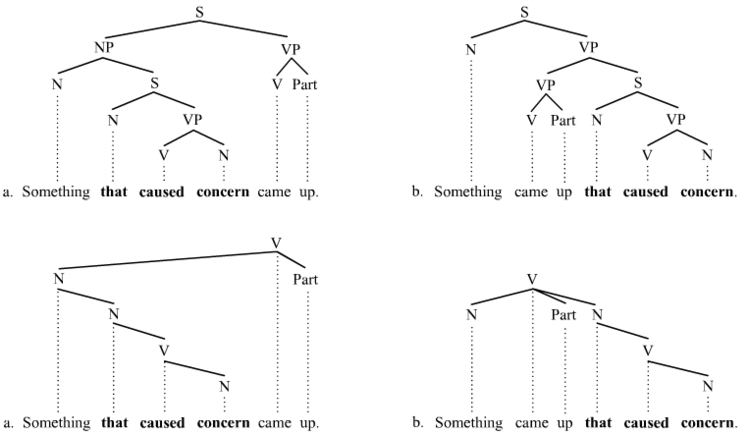 | ||
Extraposition is a mechanism of syntax that alters word order in such a manner that a relatively "heavy" constituent appears to the right of its canonical position. Extraposing a constituent results in a discontinuity and in this regard, it is unlike shifting, which does not generate a discontinuity. The extraposed constituent is separated from its governor by one or more words that dominate its governor. Two types of extraposition are acknowledged in theoretical syntax: standard cases where extraposition is optional and it-extraposition where extraposition is obligatory. Extraposition is motivated in part by a desire to reduce center embedding by increasing right-branching and thus easing processing, center-embedded structures being more difficult to process. Extraposition occurs frequently in English and related languages.
Contents
Examples
Standard cases of extrapostion are optional, although at times the extraposed version of the sentence is strongly preferred. The following pairs of sentences illustrate "normal" word order first followed by the same sentence with extraposition:
These examples illustrate a couple of basic facts about extraposition. One of these facts is that relatively "heavy" constituents are being extraposed (e.g.usually clauses and sometimes prepositional phrases). Another fact is that extraposition can occur out of subjects. This aspect of extraposition is unlike topicalization and wh-fronting, two other mechanisms that often generate discontinuities. Attempts to front expressions out of subjects fail in English. Another fact about extraposition is that sometimes it cannot occur beyond informationally heavy material.
This aspect of extraposition supports the insight that extraposed constituents should be informationally heavy. Extraposition likely fails in this case because with red hair cannot be construed as important information.
Clause bound
A further widely acknowledged fact about extraposition is that it is clause-bound. This aspect of extraposition is known as the Right Roof Constraint. There is a "right roof" above which extraposition cannot occur. In other words, extraposition cannot occur out of an embedded clause:
This aspect of extraposition is unlike fronting discontinuities (topicialization and wh-fronting), which can easily front a constituent out of an (argument) clause, e.g.
but it is like scrambling discontinuities; scrambling cannot displace a constituent from one clause into another.
It-extraposition
The term "extraposition" is also used to denote similar structures in which it appears. While certainly related to canonical cases, it-extraposition is different in at least one important respect. In cases of it-extraposition, extraposition is not optional, but rather it is obligatory, e.g.
Another aspect of it-extraposition that distinguishes it from canonical cases is that the extraposed constituent is usually a clause; it-extraposition cannot extrapose a prepositional phrase. This fact can be explained by appealing to the status of it as a cataphor. In other words, it is pro-form of a sort; its appearance pushes the clause that it stands for to the end of the sentence. Since prepositional phrases cannot appear in the position of a clause, it should not be surprising that prepositional phrases cannot be it-extraposed.
Motivation
Extraposition is motivated at least in part by the desire to reduce processing load. When extraposition occurs, it inevitably reduces center embedding and thus increases right-branching. Right-branching structures in English are known to be easier to process. The extent to which extraposition increases right-branching is now illustrated using both a constituency-based analysis of a phrase structure grammar and a dependency-based analysis of a dependency grammar. The constituency-based trees appear first above the dependency-based trees:
The a-trees, which lack extraposition, extend down, whereas the b-trees, where extraposition is present, grow down and to the right. English, like many other languages, prefers to avoid trees that grow just down. Extraposition is one mechanism that increases rightward growth (shifting is another).
Theoretical analyses
Theories of syntax vary in their analyses of extraposition. Derivational theories are likely to produce an analysis in terms of movement (or copying), and representational theories are likely to assume feature passing (instead of movement). The following trees illustrate these analyses. The movement-type analysis appears on the left in the a-trees, and the feature passing analysis on the right in the b-trees. The constituency-based trees appear again above the dependency-based trees.
On the movement analysis in the a-trees, the embedded clause is first generated in its canonical position. To increase right-branching it then moves rightward to its surface position. On the feature passing analysis in the b-trees, no movement is involved. Instead, information about the extraposed constituent is passed along the path marked in red. This path extends from the extraposed constituent to what can be viewed as the governor of the extraposed constituent. The words in red in the dependency tree qualify as a concrete unit of syntax; they form a catena.
